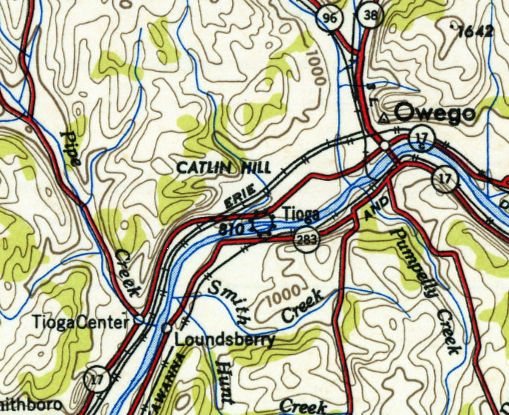
Abandoned & Little-Known Airfields:
Central New York State
© 2002, © 2016 by Paul Freeman. Revised 1/4/16.
This site covers airfields in all 50 states: Click here for the site's main menu.
____________________________________________________
Please consider a financial contribution to support the continued growth & operation of this site.
Auburn Airport / Throopsville Airport (revised 7/16/15) - Canastota Airport (revised 7/16/15) - Hayes Airport / Cicero Airpark / Michael Field (revised 7/16/15)
Ithaca Municipal Airport (revised 1/4/16) - Kamp Airport (revised 10/5/08) - Mangeot Field / Holly Brothers Airport / Reid Airport / Fulton Auxiliary Field / Fulton Airpark (revised 7/16/15)
Nedrow Airpark (revised 4/19/15) - Oneida County Airport (revised 8/28/15) - Oneida Lake Airport & Seaplane Base (revised 7/16/15)
Syracuse Municipal (revised 10/24/13) - Tioga Airport (added 10/25/15) - Tri-County Airways Airport (revised 7/16/15)
____________________________________________________
42.084, -76.304 (West of Binghamton, Y)

Tioga Airport, as depicted on the 1950 USGS topo map.
Photo of the airfield in use has not been located.
This small general aviation airport was evidently established at some point between 1945-50,
as it was not yet listed among active airfields in the 1945 AAF Airfield Directory (courtesy of Scott Murdock).
The earliest depiction which has been located of Tioga Airport was on the 1950 USGS topo map,
which depicted Tioga as a commercial/municipal airport.

The 1956 USGS topo map depicted Tioga Airport as having a single unpaved northeast/southwest runway,
with a few small buildings on the northeast side.

The earliest aeronautical chart depiction which has been located of Tioga Airport was on the January 1957 NY Sectional Chart (courtesy of Todd Keator).
It depicted Tioga as having a 2,100' unpaved runway.

The last aeronautical chart depiction which has been located of Tioga Airport was on the May 1992 NY Sectional Chart (courtesy of Todd Keator).
The depicted runway length had decreased to a mere 1,700'.

The earliest photo which has been located of Tioga Airport was a 1995 USGS aerial view looking northwest.
Tioga Airport may have been closed at some point between 1992-95,
as a closed-runway “X” symbol was visible along the runway midpoint, and no aircraft were visible on the field.
Tioga Airport was definitely closed by 1996, as it was no longer depictred on the May 1996 NY Sectional Chart (according to Todd Keator).

A circa 2010 aerial view looking north showed 2 hangars remaining on the northeast side of Tioga Airport's grass runway.
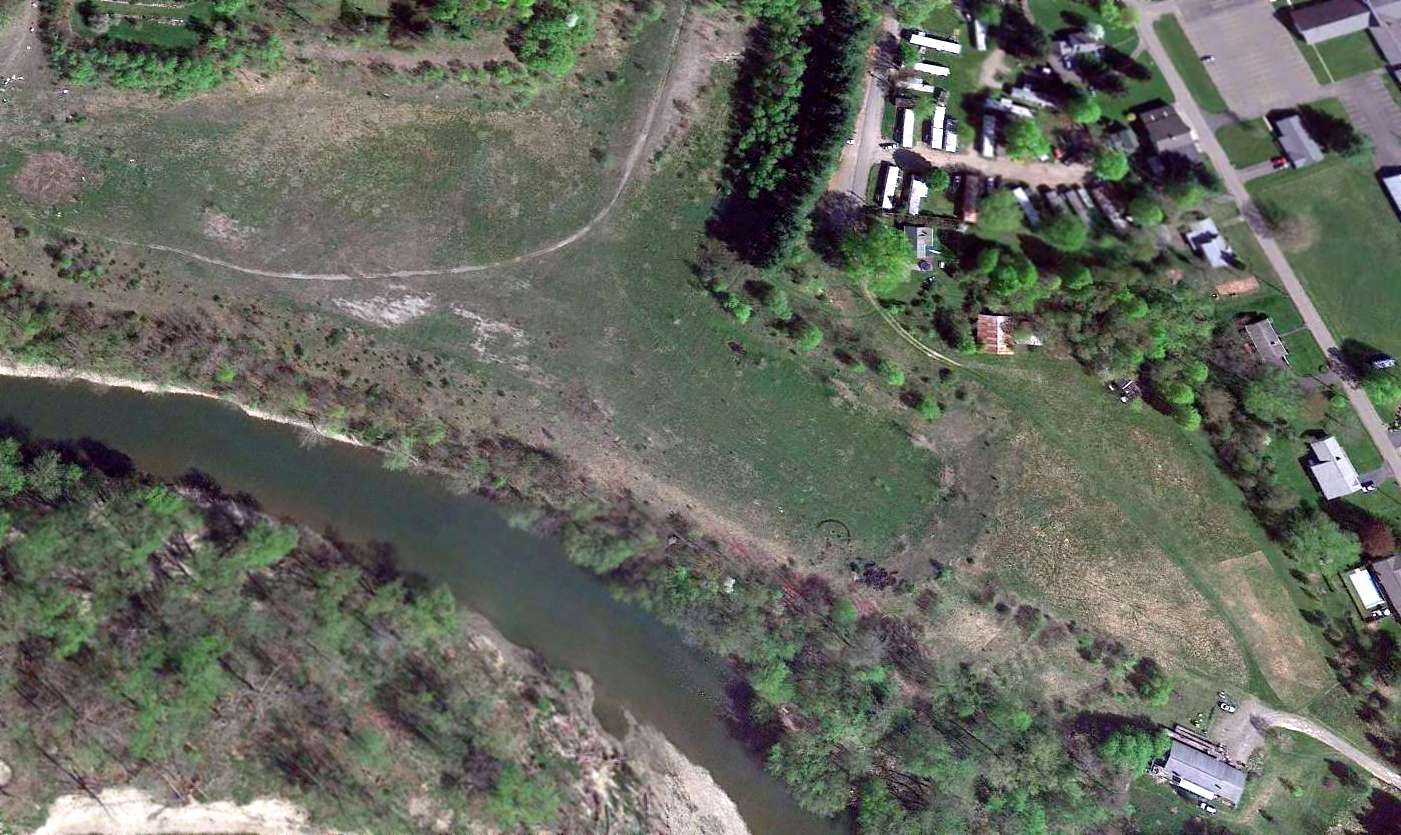
A 2013 aerial view looking northwest shows the former Tioga Airport runway remains intact, though no longer recognizable as a runway.
The 2 hangars remained standing on the northeast side.
The site of Tioga Airport is located at the southern terminus of Airways Road, appropriately enough.
Thanks to Todd Keator for pointing out this airport.
____________________________________________________
Auburn Airport / Throopsville Airport, Throopsville, Fulton, NY
42.967, -76.608 (West of Syracuse, NY)

A 10/3/42 aerial view of Auburn Airport from the 1945 AAF Airfield Directory (courtesy of Scott Murdock).
No airfield was yet depicted at this location on the 1939 USGS topo map
nor on the January 1940 Albany Sectional Chart.
According to the book “A Scrapbook History of the Auburn Aviation Company Inc. & the Auburn Airport at Throopsville 1941-52” by Robert Ingalls,
Auburn Airport began operations in 1941, operated by Auburn Aviation Company.
The earliest depiction which has been located of Auburn Airport
was a 10/3/42 aerial view in the 1945 AAF Airfield Directory (courtesy of Scott Murdock).
It depicted Auburn as having 3 unpaved runways.

The 1943 USGS topo map depicted Auburn Airport as an irregularly-shaped property outline
with one small building along the northeast side.
The 1945 AAF Airfield Directory (courtesy of Scott Murdock) described Auburn Airport
as a 128 acre irregularly-shaped property having 3 sod runways, the longest being a 2,750 west-northwest/east-southeast strip.
The field was said to have a single 78' x 68' wood & metal hangar, and to be owned & operated by private interests.

The earliest aeronautical chart depiction which has been located of Auburn Airport was on the May 1945 Albany Sectional Chart.
It depicted Auburn as a commercial/municipal airport.

The last aeronautical chart depiction which has been located of Auburn Airport
was on the 1950 Albany Sectional Chart (courtesy of Mike Keefe).
It depicted Auburn as having a 2,600' unpaved runway.
According to the book “A Scrapbook History of the Auburn Aviation Company Inc. & the Auburn Airport at Throopsville 1941-52” by Robert Ingalls,
Auburn Airport ceased operations in 1952.
The 1953 USGS topo map continued to label the site as “Airport”.
But by the time of the 1955 USGS topo map, Auburn Airport was no longer depicted at all.

A 5/6/57 USGS aerial photo depicted a clearing at the site of Auburn Airport, but nothing recognizable as an airport.

A 9/24/13 aerial view showed no trace remaining of Auburn Airport.
The site of Auburn Airport is located southwest of the intersection of Beech Tree Road & North Division Street.
Thanks to Robert Dunbar for pointing out this airport.
____________________________________________________
Mangeot Field / Holly Brothers Airport / Reid Airport / Fulton Auxiliary Field / Fulton Airpark, Fulton, NY
43.32, -76.44 (Northwest of Syracuse, NY)

Holly Brothers Airport, as depicted on the June 1933 Albany Sectional Chart.
This property was originally located on the Mangeot Farm, which was the origin of the airport's original name, Mangeot Field.
The date of establishment of Mangeot Field has not been determined.
According to Mark Hess, “The airport was operating unofficially on Mangeot Farm, north of Phillips Street on State Route 3.”
According to a 1935 article (courtesy of Mark Hess), Holly Brothers Incorporated was formed early in 1930 by Leon & Henry Holly.
This corporation acquired what was then a meadow on the north side of Phillips street and proceeded to make a real airport of it.
The first airplane was bought to Fulton in August 1930, and the first hangar ever to erected in Fulton was constructed & housed the corporation's plane.
The earliest depiction which has been located of Holly Brothers Airport was on the June 1933 Albany Sectional Chart.
It depicted Holly Brothers Airport as a commercial/municipal airport.
According to a 1935 article (courtesy of Mark Hess), Leon Holly became the first Fulton resident to procure a commercial license.
His tragic death in an air crash on 5/6/34 put a stop to all air activities for some time.
In June 1934, the Fulton airport became a TERA project.
This was the result of continuous effort of the Fulton Kiwanis Club, which sponsored this as one of their projects.
Carl Worden & Dwight Murphy were in charge of TERA work at the airport.
According to Mark Hess, “This airport had a seaplane port on Lake Neatahwanta (end of Phillips Street towards the lake).
Official dedication of Holly Airport was 6/1/35.
It was used primarily for the 27th Division, Air Service Detachment, New York National Guard.
It was an Army Airfield for Coast Artillery practice of Fort Ontario in Oswego.
There was also a Civil Air Patrol Squadron & a Civilian Pilot Training Program based at [the] airport during WWII.”

The earliest photo which has been located of Reid Airport
was a 10/3/42 aerial view looking west in the 1945 AAF Airfield Directory (courtesy of Scott Murdock).
It depicted “Reid Airport (Fulton Auxiliary Field)” as having 2 unpaved runways.
Reid Airport was not yet depicted on the 1943 USGS topo map.
The 1945 AAF Airfield Directory (courtesy of Scott Murdock) described “Reid Airport (Fulton Auxiliary Field)”
as a 56 acre rectangular property having 2 sod runways, measuring 2,000' north/south & 1,800' northwest/southeast.
The field was said to have 3 hangars, the largest being a 75' x 55' wood & metal structure.
Fulton Airpark was described as being owned & operated by private interests.

At some point between 1945-47 the airport was evidently renamed Fulton Airpark,
as that is how it was depicted on the 1947 USGS topo map.
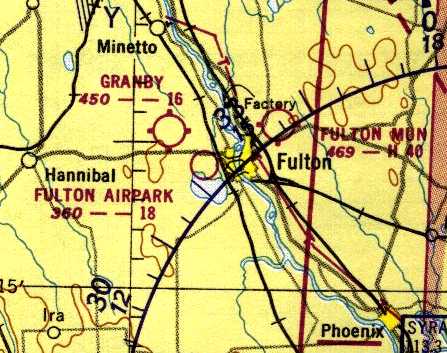
The 1950 Albany Sectional Chart (courtesy of Mike Keefe)
described Fulton Airpark as having an 1,800' unpaved runway.
According to Mark Hess, the Fulton Airpark ceased operation in 1952
(for reasons unknown, but presumably due to competition from the larger Fulton Municipal Airport on the east side of town).
By the time of the 1955 USGS topo map, the Fulton Airpark was no longer depicted at all.
By the time of a 1994 USGS aerial photo, the runways of Fulton Airpark were overgrown & no longer recognizable.

A 6/23/10 aerial view of the site of Fulton Airpark.
Mark Hess observed in 2011 that “The hangars were located where the big rectangle building (Pyramid Mall) & parking lot are located on State Route 3 (right side).”
The site of Fulton Airpark is located west of the intersection of Route 3 & Preston Street.
____________________________________________________
Hayes Airport / Cicero Airpark / Michael Field, Cicero, NY
43.18, -76.128 (North of Syracuse, NY)

Hayes Airport, as depicted on the June 1933 Albany Sectional Chart.
Hayes Airport was reportedly established in 1929.
This was the first name of the airport on Route 11, 3/4 mile north of the Four Corners.
The earliest depiction which has been located of Hayes Airport was on the June 1933 Albany Sectional Chart.

A circa 1930s advertisement for Hayes Airport.
Hayes Airport was evidently closed (for reasons unknown) at some point between 1933-40,
as it was not depicted at all on the January 1940 Sectional Chart.
At some point between 1940-45 the airport was evidently reopened under the name of Cicero Airport,
as that is how it was depicted on the May 1945 Albany Sectional Chart.

The 1945 AAF Airfield Directory (courtesy of Scott Murdock) described Cicero Airport as a 100 acre rectangular property
having a turf all-way field measuring 2,600' northwest/southeast by 1,700' northeast/southwest.
A single 100' x 60' concrete block hangar & another building were depicted on the southeast side.
The field was described as being owned & operated by private interests.

It was depicted as Cicero Airport on the 1947 USGS topo map.

An undated (circa 1940s?) ad for flight training at Cicero Airpark.

The 1949 USAF Target Complex Chart (courtesy of Chris Kennedy) depicted “Cicero Airpark” as a rectangular outline.

A 1951 aerial view looking northwest at Cicero Airpark (courtesy of Mark Hess)
depicted the field as having a single east/west runway, with an arch-roof hangar on the northeast side.
A 1956 aerial photo depicted 2 single-engine aircraft parked around Cicero's hangar.

The 1957 USGS topo map depicted “Hayes Airfield” as an irregularly-shaped property outline.
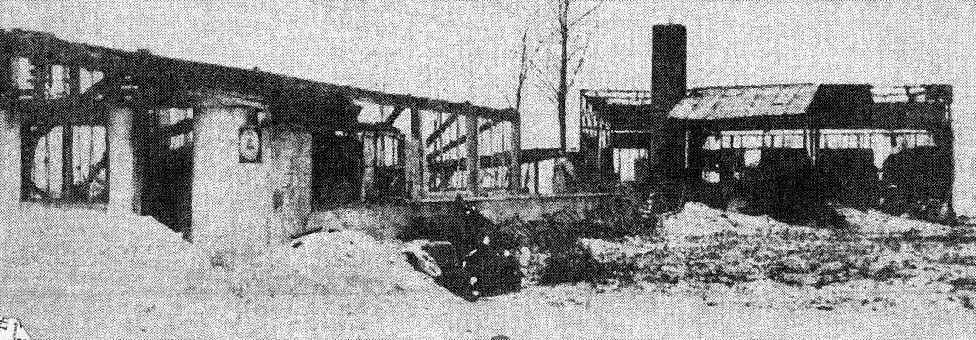
An undated photo of the twisted skeleton of the Cicero Airpark hangar from a January 1959 fire.

Two undated photos of 2 aircraft in front of the twisted skeleton of the Cicero Airpark hangar from a January 1959 fire.
It was still depicted as Cicero Airport on the 1964 Albany Sectional Chart.
It was evidently renamed Michael Field at some point between 1964-67,
as that is how it was labeled on the 1967 Albany Sectional Chart.
It described Michael Field as having a 3,000' unpaved runway.
The 1969 Albany Sectional Chart depicted Michael Field as having a 2,600' paved east/west runway.

The last aeronautical chart depiction which has been located of Michael Field was on the February 1970 Albany Sectional Chart.
A 1972 aerial photo showed 11 single-engine aircraft parked on the northeast side of the field.

The 1978 USGS topo map depicted Michael Field as having a single east/west runway, with a single hangar on the northeast side.
According to Tony Alesci, “Michael Field was last run as an active airport by William 'Bill' Michael & his son Michael 'Mickey'.
Bill died and in the early 1990s & Mickey continued to run it afterwards.
It was a one-man show. Mick did it all from aircraft maintenance to mowing the lawn & the flight instruction.
In the mid-1990s snow collapsed his hangar ruining several of his aircraft.”

A 1995 USGS aerial view looking southwest depicted Michael Field as having an asphalt east/west runway.
An asphalt parking ramp had been added along its north midpoint at some point between 1972-95.
A total of 4 single-engine aircraft were visible on the field.
Runway 28 had a significantly displaced threshold nearly halfway down its runway length.
According to Tony Alesci, “Sadly in the late 1990s Mickey fell victim to carbon monoxide while flying, crashed and died.
There was no one to take Mickey's place & the airport though legally open was dormant.”
Felix Geraets recalled, “Cicero airfield was operated by Bill Michael's son for a couple of years.
He got killed in an accident. After that,nobody took over & the airport went downhill fast.”
According to Peter Ricciardiello, Michael Field's Runway 28 displaced threshold “was most probably due to the proximity of both the busy 2-lane Brewerton Rd
and the power lines that paralleled this street, both of which ran perpendicular & close to the runway.”
When I was finishing up my Private pilot certificate out of nearby Syracuse Hancock International in 2002,
my instructor would take me to Michaels Field to practice short-field landings & takeoffs in the school’s Cessna 172.
KSYR’s Class C airspace had a very small semi-circle carved out of the inner shelf for this airport.”

Perhaps the peak of Micheal Field's usage was seen on a 7/13/05 aerial view looking southwest,
in which a total of 6 light aircraft were visible on the field.
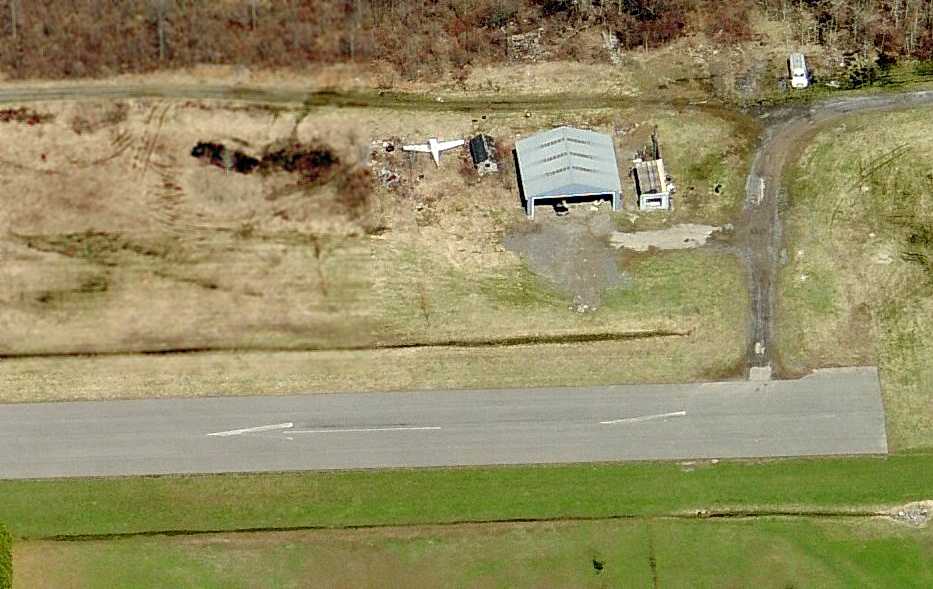
A circa 2008 aerial view looking north at the Micheal Field runway & hangar, with a tailless light aircraft next to the hangar.

The last photo which has been located showing an aircraft at Micheal Field was a 5/4/09 aerial view looking southwest.

Micheal Field was evidently closed (for reasons unknown) at some point between 2009-2010, as a 6/3/10 aerial view looking southwest
showed closed-runway X symbols painted along the runway, and no aircraft on the field.
As of 2011, street maps labeled the site as “Michael Field – Onandoga Fliight School Airport”.
Tony Alesci reported in 2012, “A few years back a couple of men bought the place as well as Syracuse Suburban Airport.”
The site of Michael Field is located northwest of the intersection of Route 31 & Route 11.
____________________________________________________
Oneida Lake Airport & Seaplane Base, Lakeport, NY
43.15, -75.878 (Northeast of Syracuse, NY)
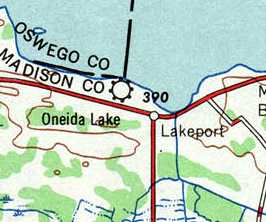
Oneida Lake Airport, as depicted on the 1948 USGS topo map.
This general aviation airport was evidently established at some point between 1946-48,
as it was not yet depicted on the July 1946 Albany Sectional Chart.
The earliest reference which has been located of Oneida Lake Airport came from Bob Roosevelt,
who recalled, “Oneida Lake Airport & Seaplane Base... I was born September 1946 & lived at this airport with my family.
My father, Robert E. Roosevelt (owned Safe Wings, Inc.) was proprietor for 3 airports: Oneida Lake, Canasota Municipal, and Kirksville.
He built Oneida Lake Airport & Seaplane Base.
Mr. Timmerman owned the property & leased it to Fremac Marine.
I have many fond memories of Dad & me. He taught me how to fly at a very young age.”
The earliest depiction which has been located of Oneida Lake Airport was on the 1948 USGS topo map,
which depicted it as a commercial/municipal airport.
Ron Centner recalled, “The airstrip at Fremac's Marine in Lakeport...
As a young boy, my father would take my brother & myself fishing out from Lakeport Bay.
My father always kept his boat moored or anchored out at a livery down at the end of lake road, called 'George Deer's' boat livery.
It was right next door to the northeast extension of the runway.
There was also a slip or marina for floatplanes right at the end of the northeast extension at the edge of the bay.
My father would let us walk a path through the bushes over to the slip where about a half-dozen of small single-engine floatplanes were tied up.”

The earliest aeronautical chart depiction which has been located of Oneida Lake Airport was on the January 1950 Albany Sectional Chart.
It depicted Oneida Lake Airport as having an 1,800' unpaved runway.

The 1957 USGS topo map depicted Oneida Lake Airport as having 3 unpaved runways, with 2 small buildings on the south side.
Bob Roosevelt recalled, “I lived at this airport with my family until 1961.”

The last aeronautical chart depiction which has been located of Oneida Lake Airport was on the February 1970 Albany Sectional Chart.
It depicted Oneida Lake as a private airfield with a 1,700' unpaved runway.
Oneida Lake Airport was evidently closed (for reasons unknown) at some point between 1970-72,
as a 1972 aerial photo showed 2 grass runways in a “X” shape, but a boat dealer occupied a portion of the property south of the runway intersection,
and there were no planes visible on the field.
A seaplane base at the northeast end of the northeast/southwest runway had 5 inlets carved into the lake shore.
Oneida Lake Airport was no longer depicted at all on the 1985 USGS topo map.

Only a “Seaplane Base” was still depicted on the 1993 USGS topo map – the runways & airport had ceased to be depicted at all.

A circa 2008-2011 aerial view looking west showed the outline of 2 grass runways in a “X” shape were still recognizable at the site of Oneida Lake Airport.
A boat dealer occupied a portion of the property south of the runway intersection.

A 6/3/11aerial view depicted the site of Oneida Lake Airport still having the recognizable outline of 2 grass runways in an “X” shape.
The site of Oneida Lake Airport is located northwest of the intersection of Lake Street & Lake Road.
____________________________________________________
Tri-County Airways Airport (NY53), West Edmeston, NY
42.74, -75.3 (Northwest of New York, NY)

Tri-County Airport, as depicted on the 1964 Albany Sectional Chart.
No airfield was yet depicted at this location on the May 1960 Albany Sectional Chart.
According to its FAA Airport/Facility Directory entry, Tri-County Airways Airport was activated in October 1961.
Vern Maine recalled, “My first airplane ride as a kid was in a J-3 Cub at NY53 Tri-County Airport in the 1950s,
a little grass strip on an old rail bed in West Edmeston, along side Route 8 & the Unadilla River.
It was the result of cooperation by 3 farmers, presumably interested in flying, who agreed to contribute their respective piece of the land required for the strip.”
This airport may be unique in that the runway was built along a ripped-up former railway bed.
The earliest depiction which has been located of Tri-County Airport was on the 1964 Albany Sectional Chart,
which depicted it as having a 3,000' unpaved runway.
The 1990 USGS topo map shows the railroad passing right through the alignment of what would eventually become Tri-County's runway,
but does not yet depict the airport.

The 1994 USGS topo map depicted the railroad running right up to both ends of the Tri-County Airport's unpaved runway.

The oldest photo which has been located of Tri-County Airport was a 5/17/97 aerial view looking southwest,
which showed a single unpaved runway, with a single small building on the northeast side.

The earliest photo which has been located showing aircraft at Tri-County
was a circa 2006-2011 photo looking west at a shed on the north side, which appeared to hold 2 or 3 Cessnas.
According to Vern Maine, the hangar spanned “6 bays”.

A 5/4/09 aerial view looking southwest at Tri-County Airport showed a single unpaved runway, with a single small building on the northeast side.

A 2010 photo by Vern Maine of Tri-County “of my RV-3 in the hangar from my last flight there.
In hindsight, I guess it does look a little rickity & run-down.”

The last photo which has been located of Tri-County Airways Airport was a 6/11/10 photo (courtesy of John King)
of a Cessna 172 & a “Piper Colt that my wife used to own about 15 years ago that was based there.”
In 2011, its last year of operation, Tri-County Airways Airport's FAA Airport/Facility Directory entry
described it as a private field having a single 2,804' turf Runway 4/22.
The owner & manager was listed as Marvin Maxson,
and the field was said to have 5 single-engine aircraft based on the field.
Vern Maine recalled of Tri-County, “I flew in many times over the years from my home in New Hampshire
to visit my parents over the hill in Brookfield, right up to 2010.
The old hangar collapsed last winter [2010].”

The last depiction which has been located of the Tri-County Airport was on the 2011 Sectional Chart.
It depicted Tri-County as a private field having a 2,800' unpaved
Vern Maine reported of Tri-County, “The runway was plowed over this year, 2011 and put into corn.
A sad day. No one but me seems to care.”
Tri-County Airways Airport is located southwest of the intersection of Route 8 & County Highway 99.
____________________________________________________
Oneida County Airport (KUCA), Utica, NY
43.145, -75.38 (Northwest of New York, NY)

Oneida County Airport, as depicted on the June 1953 Hudson River World Aeronautical Chart (courtesy of Chris Kennedy).
The Oneida County Airport was evidently established at some point between 1950-52,
as it was not yet depicted on the 1950 Albany Sectional Chart (courtesy of Mike Keefe) nor the 1952 USGS topo map.
According to the Oneida County Airport website,
in 1952 Robinson Airlines made Oneida County Airport its hub.
It provided DC-3 air service to virtually every major city in the Northeast.
The earliest depiction of the Oneida County Airport which has been located
was on the June 1953 Hudson River World Aeronautical Chart (courtesy of Chris Kennedy).
It depicted Oneida County as having a 5,000' paved runway.

The 1955 USGS topo map depicted the Oneida County Airport as having 2 paved runways, multiple taxiways, and 3 small buildings.
According to the Oneida County Airport website, Robinson Airlines was taken over in a buyout in 1956.
The name was then changed to Mohawk Airlines.

An undated postcard of a Mohawk Airlines DC-3 in front of the Oneida County Airport control tower.
Mohawk Airlines continued service from the Oneida County Airport
to points in the Northeast, adding flights to Montreal, Quebec City, and Toronto
with the purchase of Convair turboprops.

The 1960 Jeppesen Airway Manual (courtesy of Chris Kennedy)
depicted the Oneida County Airport as having 2 paved runways: 5,000' Runway 15/33 & 4,400' Runway 9/27.
In 1960 Mohawk had enplanements in excess of 40,000 per year
and the purchase of BAC-111 jets boosted enplanements to over 55,000 by 1970.
Mohawk Airlines employed over 400 people in 1970.
The variety of flight options offered by Mohawk Airlines
made Oneida County Airport the transportation hub of the Mohawk Valley.
In addition to its executive offices, reservation center, and maintenance facility
Mohawk Airlines also established a jet training facility at the airport.
The combination of these facilities & services made Oneida County Airport the premier regional airline hub at the time.
In 1970, Allegheny Airlines, based in Washington, DC, purchased Mohawk Airlines
and continued to utilize the Oneida County Airport as its hub.
However in 1975 Allegheny Airlines relocated its Oneida County operations,
which included reservation centers & maintenance facilities, to Pittsburgh.
Brien Miller recalled, “Oneida County (UCA) was marvelous, albeit small field. Well kept, and fun to shoot.
As I recall, there was an NDB to it that had you turning over a race track.
If you actually shot it in low visibility at night when there was a race on,
the glow from the race track was a solid visual on where you'd be turning into [Runway] 33.”
In 1978 Paul Quackenbush founded Empire Airlines, and began service with twin-engine Navajos.
Empire began to fill the void left by Allegheny's departure.
In 1980 Empire purchased 10 Fokker 28 jets
and in 1981 began to utilize the reservation & maintenance center left vacant with Allegheny's departure.
Empire's growth in the mid-1980s, coming from added flights to New England & the Middle Atlantic states,
made it one of the busiest regional jet carriers in the Northeast.
There were over 24 departures per day in 1987.
In 1987 Empire was acquired by Piedmont Airlines.
Several years later Piedmont merged with USAir, formally Allegheny Air.
Both Piedmont & USAir utilized the reservation & maintenance facilities
until USAir relocated the operations to various locations in 1995.
USAirways began to downsize its operations at Oneida County Airport in 1995.
At this time it discontinued its DC-9 & 737 service.

A 1995 photo by Jim Hann of a 1980 Piper Aerostar 600 at Oneida County Airport.
Jim recalled, “The primary airplane that I flew, all operated by USCheck, now AirNet Express.
We hauled canceled checks between bank processing centers, only 2 seats up front.
Utica has a Federal Reserve Bank & also had a processing center for one of the big banks in the northeast.
The outside shot of 45M pictures the plane sitting directly in front of the FBO where the county fuelers worked out of.
There was no Signature or Basler or AMR Combs FBO, just the County. The county did all the fueling, and it wasn't cheap (for the time).
The hangar you can see in the picture housed equipment such as tugs, and deicers, not airplanes, it was fairly old but in decent shape.”
Jim Hann recalled, “I only flew out of there a couple of months & actually lived closer to the base than UCA.
The airport was (and probably still is) in good shape, all the ramps, taxiways, and runways were smooth,
there was an ILS approach to both ends of Runway 15/33 and they did a pretty good job of keeping the snow off the runways & taxiways.
There was also the Horizon hotel right on the main drag into the airport. It wasn't bad for a small town airport hotel.”

A 1995 photo by Jim Hann of a Piper Aerostar 601 inside the main community hangar at Oneida County Airport.
Jim observed, “There were several resident aircraft & then the transients.
Commutair kept 2 Beechcraft 1900Ds in there every night. USCheck always had 2 slots for Barons & Aerostars.
The MU-2 was also a check-hauler, Epps Air headquartered in Atlanta.
There was a Seneca I in there that might have also hauled some checks, but I believe it was based there.
There was a pair of Falcon 20s owned by a union (clothing workers?) that flew rarely.
Also a Twin Commander, a Cessna 421, and a Cessna Citation.
There were a bunch of T-hangars and other group storage hangars in addition to a maintenance hangar that always had airplanes in it.”
According to the Oneida County Airport website,
Commute Air, a subsidiary of Continental Connection flew Beech 1900s from Oneida County Airport
until it discontinued service on June 30, 2002.
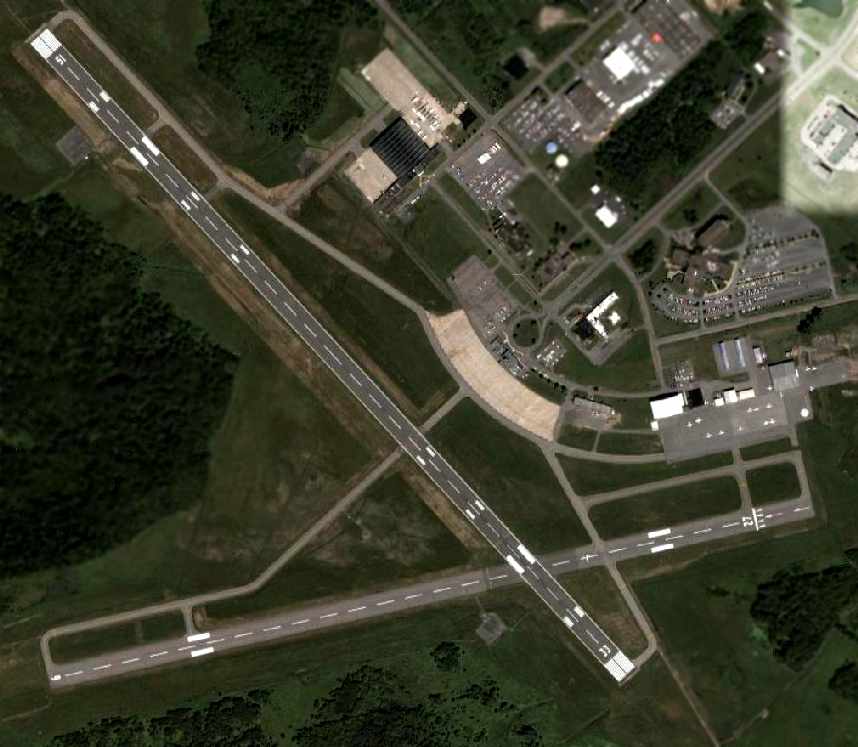
A 2006 aerial photo of the Oneida County Airport.

A 2006 aerial photo depicted a total of 17 light single & twin-engine aircraft on the east ramp of the Oneida County Airport.

An undated aerial view looking east at the Oneida County Airport while the field was in operation.

The November 2006 Albany Sectional Chart depicted Oneida County Airport as having 2 paved runways, with the longest being 6,000'.
In its last year of operation, Oneida County Airport encompassed 1,800 acres.
Joe Peters recalled, “This is where I learned to fly.
UCA was a great airport. The runways were about 6,000', and occasionally you'd see 737-sized aircraft on the ramp.
It was most common to take off from either Runway 15 or 27.
Never in my experience had I heard a controller issue Runway 9 for takeoff or landing.
Oneida County Airport closed in late 2006, and all operations were relocated to former Griffis AFB, about 5 nm North.
The county felt as though its operations had stagnated at UCA,
and decided to utilize the former air base as the local economy had been adversely impacted from the AFB closure in 1995.”

A circa 2007-2010 aerial view looking north at the Oneida County Airport control tower, after the field's closure.

A circa 2007-2010 aerial view looking north at the Oneida County Airport's east ramp, after the field's closure.

A 6/28/09 aerial view looking north at Oneida County Airport by Joe Peters, showing the field to remain intact.

An 8/25/15 photo by Ron Plante looking southwest at the former Oneida County Airport control tower.
Ron reported, “The former terminal building looks great, the airport is now a State Preparedness Training Center (SPTC).
The staff was very polite but would not allow me to take any photos of the site, only from the public access road.
They did give me a hand-out with their website: http://www.dhses.ny.gov/sptc/
which has a 3 minute video that has some scenes of training on the runways: http://www.dhses.ny.gov/sptc/video.cfm”
____________________________________________________
Ithaca Municipal Airport, Ithaca, NY
42.455, -76.52 (Northwest of New York, NY)

A circa 1920s photo of a Curtiss JN-4 Jenny biplane overflying another at Ithaca Airport (courtesy of Eileen Brackett).
The original airport for the town of Ithaca was located on the southern edge of Cuyuga Lake.
The date of construction of Ithaca Municipal Airport has not been determined.
The Ithaca Airport is believed to have been the 2nd airport in New York State,
according to the website of the current Ithaca Airport.
According to the Centennial of Flight website (via Chris Kennedy),
the Thomas Brothers Aeroplane Company moved to Ithaca in 1914,
so the airfield may date from that time.
The Thomas Brothers Aeroplane Company later merged with Morse Chain Company in 1917
to become Thomas-Morse Aircraft Corporation.
The earliest depiction which has been located of Ithaca Airport
was a circa 1920s photo of a Curtiss JN-4 Jenny biplane overflying another (courtesy of Eileen Brackett).
Eileen Bracket observed, “I believe an airshow as there are a ton of people standing in the trees.”

A circa 1927 photo of a an unidentified seaplane inside a hangar at Ithaca Airport (courtesy of Eileen Brackett).
According to Eileen Brackett, “The plane in the hanger needing repair was probably the one in abt 1927s that grandfather crashed & they brought it back to the airport.”

A 1927 photo of a an large number of aircraft & spectators at Ithaca Airport (courtesy of Eileen Brackett).
Barbara Hughes recalled, “My parents, Herbert & Dorothy Peters owned & operated the Ithaca Flying Service at the Ithaca Airport.
Dad born in 1900, started at the airport probably in his 20s. By 1927 he had 3 little girls to nurture when most people thought if God meant you to fly, you'd have wings!
He delivered air mail by dropping it out of the plane.
He piloted for aerial shots for some early motion pictures filmed in Ithaca.
Lindbergh & Amelia Earhart came to our airport & we owned the sister ship of the Spirit of Saint Louis.
The first hangar was at the north end of the property, a pretty swampy area loved by duck hunters.
Dad would shoo them away when planes were active, sometimes rewarded with a duck or two for the table.”
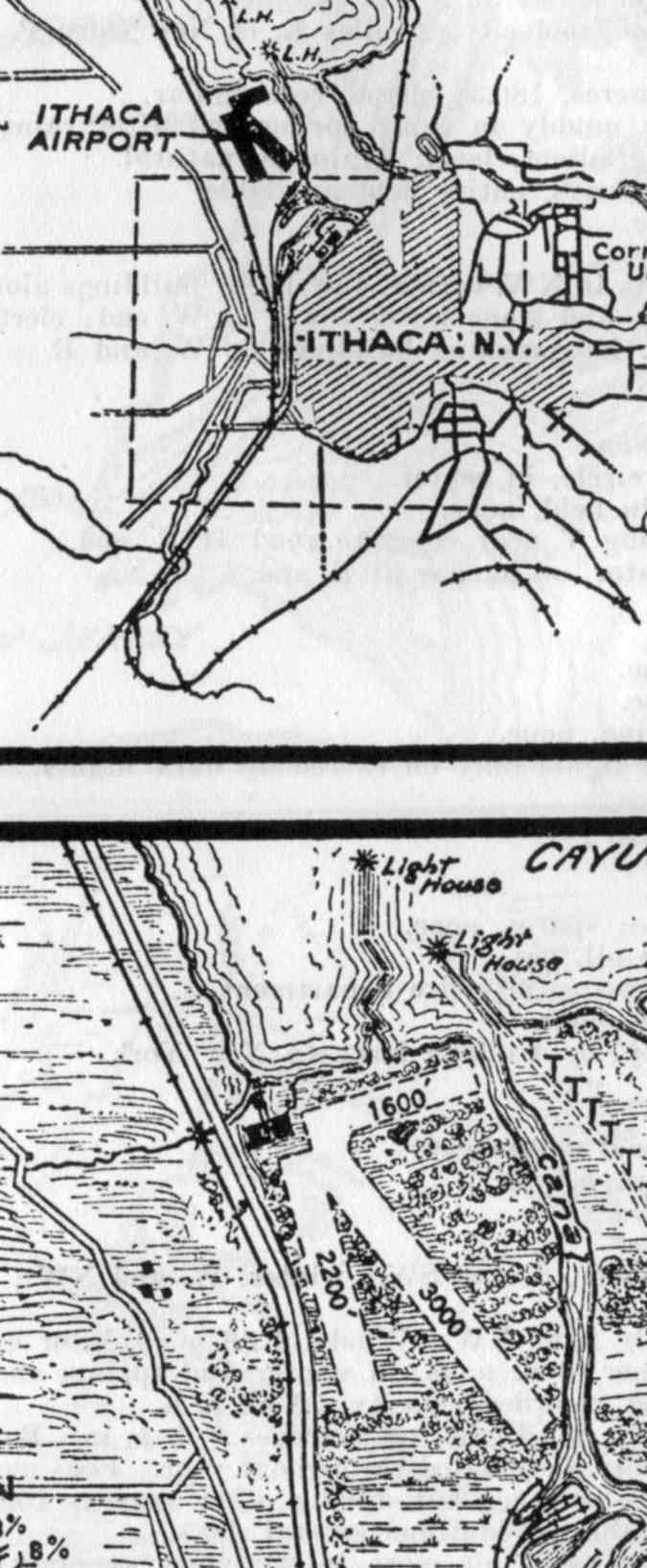
The earliest map depiction which has been located of Ithaca Airport
was on a 1929 NY Legislative Report (courtesy of Tom Heitzman).
It described Ithaca Airport as a 110 acre irregularly-shaped sod field, having 3 runways, the longest measuring 3,000' northwest/southeast.
The airfield was said to be owned by the city, and operated by Thomas Morse Aircraft Corporation.
The 1929 Rand-McNally Standard Indexed Map with Air Trails of NY (courtesy of Chris Kennedy)
described Ithaca Field as a municipal airport, operated by the Thomas-Morse Aircraft Corporation.
The airfield was said to measure 2,700' x 1,500'.
The Airport Directory Company's 1933 Airports Directory (courtesy of Chris Kennedy)
described Ithaca Municipal Airport as having 2 sod runways, 3,000' northwest/southeast & 2,600' north/south.

The earliest aeronautical chart depiction which has been located of Ithaca Airport was on the June 1933 Albany Sectional Chart.

A circa 1930s photo of the hangar at Ithaca Airport (courtesy of Eileen Brackett).
Barbara Hughes recalled, “The Works Progress Administration was responsible for the much improved, larger hangar & runways.
I believe Dad was its manager from the start of the new building & perhaps for a while the earlier hangar.”
His passion was engines & flying. Some of the earliest manufacturers of small planes would bring them to Dad to test out.
He was 6 foot 4 inches, tall for the time, and 'Pete' had to give his stamp of approval before production would continue.
That really means he could get in & out, and there were no 'dumb bunny' mistakes in its workings.
I recall Cornell Professors inviting him up to lecture the aeronautical engineering classes, he had such a solid understanding of flight.”
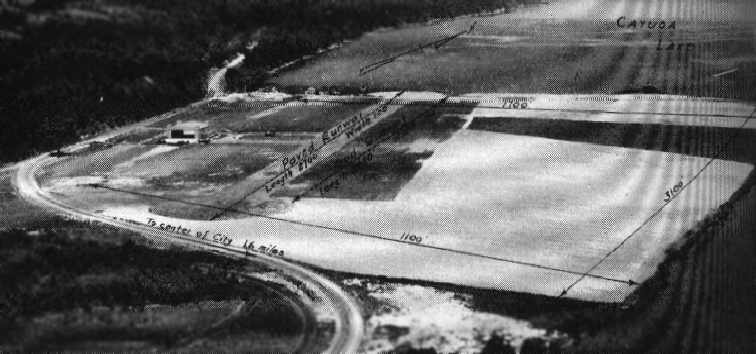
An aerial view looking northwest at the Ithaca Municipal Airport
from The Airport Directory Company's 1937 Airports Directory (courtesy of Bob Rambo).
The directory described the field as having a single 2,700' north/south asphalt runway,
along with a 2,250' east/west turf strip.
A single hangar was depicted on the west side of the field.
Barbara Hughes recalled, “The hangar was large in my mind's eye. I know we tipped the Cubs up into dollies on their noses so we could stack them. It held a lot that way.
Dad's personal plane had its own special corner. The huge heavy metal doors we'd roll closed on the north & south sides of the hangar each night.
I recall maybe 8-10 T hangars for the customers who owned their own planes.
There was also a building next to the apron where Link classes were held during WW2.
We were training pilots, it seemed day & night at that time, the need was so great.
Inside the hangar was the office where Mom & clerks kept track of flights & hours flown.
There was a waiting room then the shop where I recall the planes being stripped of their 'skin', motors refurbished & new fabric stretched & sprayed with dope.
I was told to stay out at those times, but loved the smell!”

An 8/18/42 aerial view looking northwest from The 1945 AAF Airfield Directory (courtesy of Scott Murdock)
depicted Ithaca Municipal Airport as having a single paved runway, with several light aircraft on the ramp
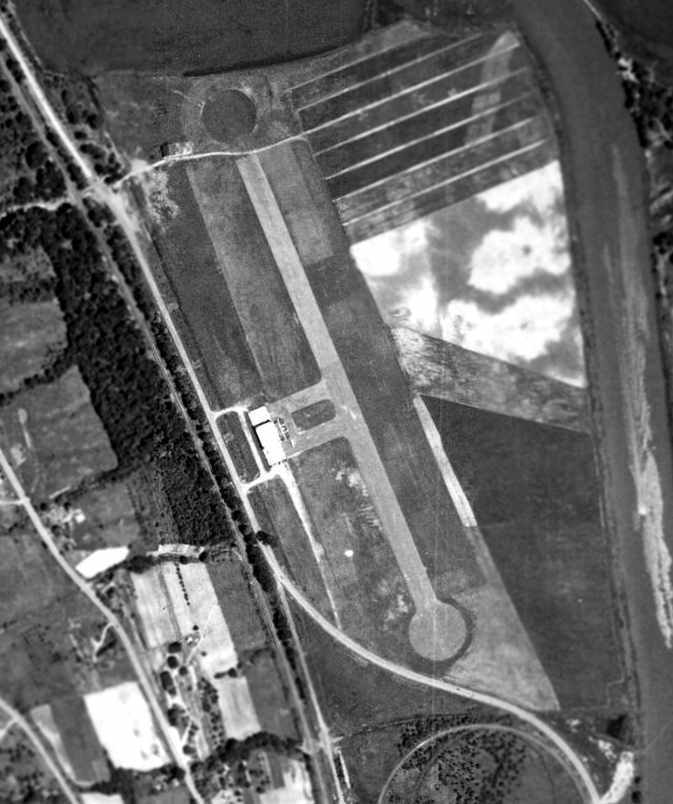
A 1938 aerial view depicted the Ithaca Municipal Airport as having a single northwest/southeast paved runway,
with a single hangar on the west side of the field.
The April 1944 US Army/Navy Directory of Airfields (courtesy of Ken Mercer)
described Ithaca as having a 2,500' unpaved runway,
and indicated that Navy flight operations were conducted from the field.
The December 1944 Army/Navy Directory of Airfields (according to Ron Plante)
described a Ithaca as having a 2,500' hard-surface runway.
According to the website of the current Ithaca Airport,
"Cecil Robinson began conducting aerial photography mapping for the government out of Ithaca Municipal Airport.
His two 4-place monoplanes became the cornerstone of Robinson Airlines at the end of the Second World War.
Shortly thereafter, Robinson Airlines was growing & their operation was moved to the new East Hill Airport,
opened by Cornell University in 1948."
[This new East Hill Airport eventually became the present-day Ithaca Airport].
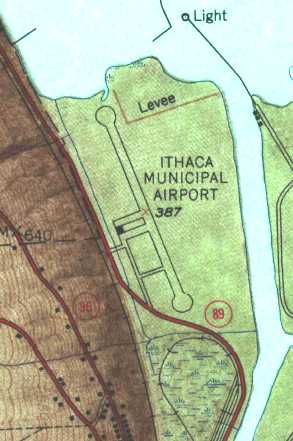
The 1949 USGS topo map depicted Ithaca Municipal Airport as having a single northwest/southeast paved runway,
with taxiways leading to a single hangar on the west side of the field.
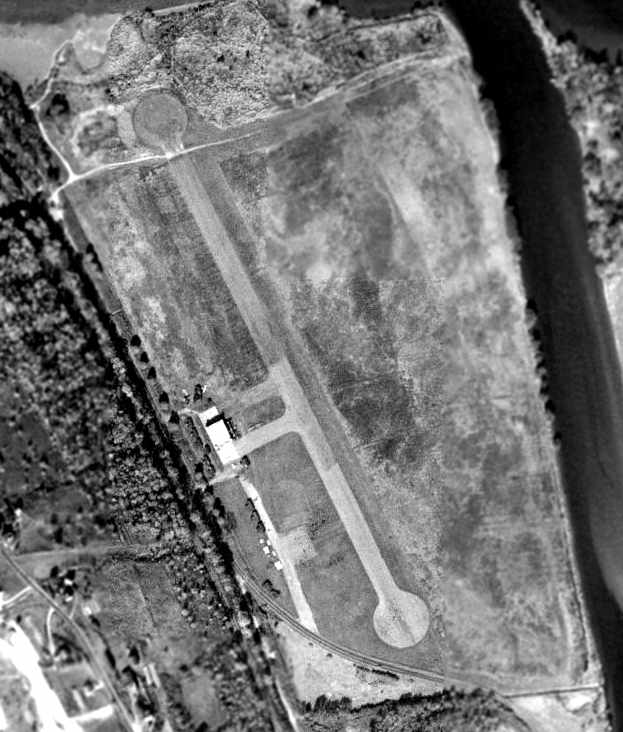
A 1954 aerial view depicted the Ithaca Municipal Airport as largely unchanged compared to the 1938 photo.
Several aircraft were visible in front of the hangar on the west side of the field.

A 1954 photo of Mert Doyle & Chi Lee in front of a Piper Cub & the hangar at Ithaca Airport (courtesy of Eileen Brackett).

A circa 1950s photo of the Ithaca Flying Service business card (courtesy of Eileen Brackett).
Barbara Hughes recalled, “Dad [Herbert Peters] held the 'title' of being the longest Fixed Base airport operator in the country,
I believe up until the time he retired & chose not to renew his lease of land from the city. That was around 1960.”
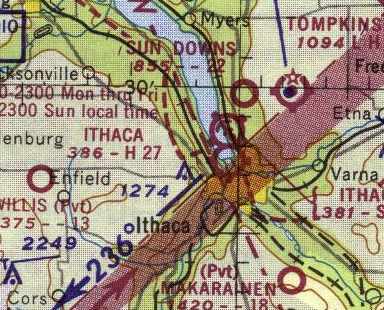
The 1962 Albany Sectional Chart (courtesy of Mike Keefe)
depicted Ithaca Municipal Airport as having a 2,700' hard surface runway.
Ron Plante recalled of the original Ithaca Airport, "This closed before we moved to nearby Cortland in 1962,
but a teenager in the 1960s I recall picnics in Cass Park & seeing the hangar, which later became a theater."

In a 1964 aerial view of the Ithaca Municipal Airport the field was still completely intact,
but the runway was unmarked & no aircraft were visible on the field.
Other sources claim Ithaca Municipal Airport closed in 1966.
By the time of the 1967 Albany Sectional Chart (courtesy of Mike Keefe),
the original Ithaca Airport was no longer depicted at all.
A 1968 aerial view showed Ithaca Municipal Airport remained intact,
but 3 closed-runway X symbols had been painted on the runway at some point between 1964-68.
In 1975, the Hangar Theatre was opened in the original hangar from the former airport.
By the time of a 1980 aerial view, only a southern portion of the runway pavement still remained,
but the hangar still remained standing.

The 1995 USGS aerial photo showed that the former hangar still remains standing (left-center of photo),
as well as what appears to be the southern half of the former asphalt runway
(running south-southeast toward the light-colored building at the bottom of the photo).
A marina inlet had been dug over the northern area of the former airport.
As of 2004, the Hangar Theatre continues to operate in the original hangar from the former airport.
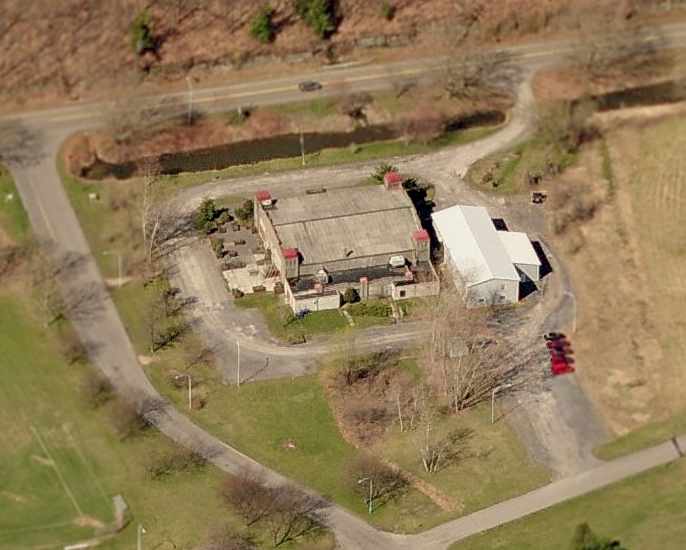
A circa 2006 aerial view looking west at the former hangar at the site of the original Ithaca Airport.

A 2008 photo by Ron Plante of the former hangar at the site of the original Ithaca Airport.
The site of the original Ithaca Airport is located east of Route 89, in Cass Park.
Thanks to Ron Plante for pointing out this airfield.
____________________________________________________
Canastota Airport (1B8), Canastota, NY
43.07, -75.77 (East of Syracuse, NY)

Canastota Airport, as depicted on the January 1940 Albany Sectional Chart.
According to Canastota Village Historian David Sadler, “Amelia Earhart dedicated the Canastota Municipal Airport on 8/28/28.
Otto Herrmann was one of the leading organizers to establish an airport in Canastota.”
However the Canastota Airport was not yet depicted on the June 1933 Albany Sectional Chart,
even though it depicted Airway Beacon #34 at the eventual site of the airport.
The earliest directory listing of Canastota Airport which has been located
was in The Airport Directory Company's 1937 Airports Directory (courtesy of Bob Rambo).
It described Canastota as an auxiliary airfield having two 2,000' sod runways, oriented east/west & northeast/southwest.
A beacon on a tower with red course lights was said to flash a characteristic "4".
The earliest depiction which has been located of Canastota Airport was on the January 1940 Albany Sectional Chart.
Canastota Airport was dedicated as a base of operations for the Civil Air Patrol on 7/3/43,
according to a 7/4/43 Syracuse Post-Standard article (according to CAP Major Nancy Bridges).

The earliest photo which has been located of Canastota Municipal Airport
was a circa 1943-45 aerial view looking north from the 1945 AAF Airfield Directory (courtesy of Scott Murdock).
CAP operations at Canastota were evidently extremely brief, though,
as they were transitioned from Canastota Airport to Hayes Airfield on 9/5/44 (according to CAP Major Nancy Bridges).
Canastota Airport was turned back to the village of Canastota effective 9/1/44,
and a hangar built by CAP was also given to the village.
The April 1944 US Army/Navy Directory of Airfields (courtesy of Ken Mercer)
described Canastota Airport as having a 2,200' unpaved runway.
According to Canastota Village Historian David Sadler,
“During WWII U.S. built P-51 Mustangs from the Royal Canadian Air Force were at the Canastota Airport with one crashing.”
The 1945 AAF Airfield Directory (courtesy of Scott Murdock) described Canastota as a 192 acre rectangular property having 2 “sod & gravel (rough)” runways,
the longest being the 2,200' east/west strip.
The field was said to have 5 wooden hangars, the largest being a 40' x 38' structure.
Canastota Municipal Airport was described as being owned by the City of Canastota, and operated by the Civil Air Patrol.
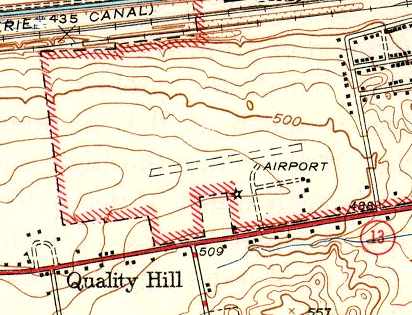
The 1946 USGS topo map depicted Canastotata Municipal Airport
as having a single east/west runway, labeled generically as "Airport".
A cluster of several small buildings was situated on the southeast corner of the field,
and the beacon was depicted on the south side of the runway.
Bob Roosevelt recalled, “My father, Robert E. Roosevelt (who owned Safe Wings, Inc.)
was proprietor for 3 airports: Oneida Lake, Canasota Municipal, and Kirksville.”

The runway at Canastota had evidently been lengthened at some point between 1944-50,
as the 1950 Albany Sectional Chart (courtesy of Mike Keefe)
depicted Canastota as having a 3,200' unpaved runway.
According to Brien Miller, “The original strip was something like 2,000-2,300' long.
According to the pilots at the field, some time in the late 1940s or early 1950s somebody decided to buy and renovate 3-5 surplus P-51s.
That's when the field got it's extra 800-900' or so on the west end -
and it was very obvious because they didn't level the west end as it should have been done.
The field had a slight rise at the departure end of [Runway] 27 as it was,
with the addition, there was a bump & a bit more uphill to go.
The story told around the field was that 1 or 2 of the P-51s crashed on takeoff at various points
because the purchasers firewalled the throttle on take off, which you never did with those high performance fighters -
you ease it up so that the P-factor wouldn't corkscrew you into the ground.”
A 1956 aerial photo showed a dozen light aircraft at Canastota.
Bill Ryan recalled, “I worked at Canastota as a kid pumping gas & towing gliders.
I knew Herb's dad & Robbie his brother.”
George Johnson recalled, “I remember flying into Canastota Airport in 1958 on my solo cross-country.
I was surprised to see an entire Canadian squadron of P-51s all over the airport
and for sale for the huge sum of $2,300.”
Bob Sollien recalled, “Back around 1959 or 1960 my father Earl Sollien became the manager of the Canastota Airport & it’s flight instructor.
In Canastota we lived just across the road from the airport on the other side of Route 5 - a few houses up the hill from Joe Tornatore’s place.
He taught there for a couple of years.”
Mark Hrutkay recalled, “This is the airport where in 1960-62 or so the RCAF P-51s came through.
There were about 25 Mustangs (civilian) on the field which were being prepared to ship to Central America, and point south.
There was one that crashed there in about 1961 which got torque-rolled over the hill on the left of the runway (big field in top of picture) on takeoff.”
Canastota gained a paved runway at some point between 1950-62,
as the 1962 AOPA Airport Directory described Canastota Municipal Airport
as having a total of 3 runways: a 3,200' paved Runway 9/27,
a 1,500' turf runway 4/22, and an 800' turf Runway 18/36.
The operator was listed as Canastota Aircraft, Inc.
Mark Hrutkay recalled, “Canastota... my father had a GC1B Swift there.
[In photos of the ramp], The lower right hand corner has a circe in the pavement. That was the main ramp.
The Fixed Base Operation hangars were on the left of that.
A square & round building [was] the hangar that Dad had the Swift in with Leo & Eddie,
the 'Ercoupe Brothers' who were 2 electricians that each had Ercoupes.”
Mark continued, “In about 1965 there was a MAJOR windstorm that about wiped out the airport.
Every hangar was flatenend except the FBO & the one dad's plane was in.
There was a long set of T-hangars between the FBO & dad's hangar which fell over.
Planes had their wings bent when ties-downs didn't break & flipped over when they did. A real disaster.”
Sterling Brisbin recalled, “Canastota Airport was the site of my first general aviation experience as a boy in the late 1960s,
when my father's business partner, Gordon Wheler, was kind enough to take me on a flight in his Cessna 210 that was based there.
He let me fly the takeoff & I still remember trying uselessly to counteract the torque swerve to the left with right aileron!”

The Canastota Airport, as depicted on the 1969 Albany Sectional Chart (courtesy of John Voss).

An early 1980s photo by Brien Miller looking southwest at Canastota Airport's main buildings.
Brien reported, “This was the main area off the ramp. The ramp had a compass rose painted on it but with not headings marked, just an extra large north pointer.
The white building in the foreground was the FBO: run by a guy named Joe Tornatore; Joe was always good about plowing the airport in the winter.
The old beacon is visible in this shot. The beacon was originally designed only to be seen east/west -
as that was the mail route used: Albany – Schenectady - Utica (Riverside) – Canastota - Syracuse - then west.
The blue-green building on the right was Herb Reuter's Aircraft Sales & Repair.
Herb (as I recall being told) was an ex Pan Am Clipper A&P - his German accent was quite heavy.
He also had an early WWII Link flight simulator parked in that building.
The grey-brown building on the left under the beacon was a mystery building. Never saw it open - nobody talked about it.
Still to this day have no clue as to who owned / used it & what was kept in it.
The wind sock shows a strong west wind favoring Runway 27.”

The only photo which has been located showing aircraft at Canastota Airport was an early 1980s photo by Brien Miller looking south Several Cessnas.
Brien reported, “That's the field's Cessna 152 Aerobat in the compass rose.”
The 1982 AOPA Airport Directory (courtesy of Ed Drury) described Canastota Municipal Airport
as having a 3,200' paved Runway 9/27 & a 1,500' turf runway 5/23.
The operators were listed as Canastota Aircraft Company, Reutter Aircraft Service, and Bisha Avionics.
Herb Reutter recalled, “My father & and brother operated the airport until it closed by order of the city in the early 1980s.
I was all set to return to my roots & join the family business
after the City fathers had voted to accept Federal funding to extend & reorient the paved runway.
It was going to be a major upgrade, and would have allowed small business jets to land,
which would have been good for the business.
The city fathers later changed their minds & voted to close the airport
and make it into an industrial park reasoning that they would make more money that way.
In reality, developers who owned nearby land were anxious to rid the area of the 'noise' & make their property more valuable.
My father had to move his business to Oneida County Airport
and leave the hangar & shop he had invested his money in.
In reality, it turned out to be a good move.
A longer commute from his home maybe,
but he ended up with more business & better accommodations at Oneida.
And as he put it, he didn't have to deal with the fickle small town politics anymore.
Actually he had more descriptive words for the Italian city fathers.”
Brien Miller recalled, “The demise of Canastota was purely political:
the local mayor wanted the land to the east to build apartments on with his brother-in-law.
Initially, the idea was quashed but he played dirty & managed to get the Fixed Base Operator removed.
He then sited an 'industrial development park' at the far end of Runway 27 that actually required a road to be driven across the runway.
He claimed that the airport would be a boon to such a park - but his goal was to kill it.
This he did in a later effort - but the town was going downhill under his poor leadership
and both the airport & the industrial park closed.
While Kamp's demise was foreseeable; Canastota's was simply wrongful greedy local politics
and a waste of a fine & historic airfield at which Amilia Earhart once landed.”
According to Canastota Village Historian David Sadler, Canastota Municipal Airport closed on 12/31/89.

The Canastota Airport was still depicted on the 1993 USGS topo map,
even though it was evidently already closed by that point.

The 1994 USGS aerial photo of the site of Canastota Airport
showed that several buildings had been built directly adjacent to the west side of the former paved runway,
which was also being used to store some kind of unidentified items (trailers?).
The entire length of the runway remained intact, and the number "9" was still intact on the western end of the runway.
The former ramp on the southeast side of the field also remained intact, along which were several buildings (possible former hangars?).

A 2002 photo by Mark Hrutkay of “the hangar next to the main terminal (which is gone).
They used to have Republic Seabees in there (2 or 3 of them).”
Mark Hrutkay recalled, “I was last there in about 2003 & there were houses built in the right side of the picture over part of the field.”
Herb Reutter reported in 2005, “The grand industrial park [which was intended to replace the airport]
is now hodgepodge of dilapidated buildings.”
A circa 2006 aerial view appears to show that the remaining hangar has been modernized (recovered) or replaced.
Canastota Village Historian David Sadler reported, “I successfully petitioned the Village of Canastota
to have a historical marker placed at the entrance on NY Route 5 & Dominic Bruno Boulevard (the former airport access road).”
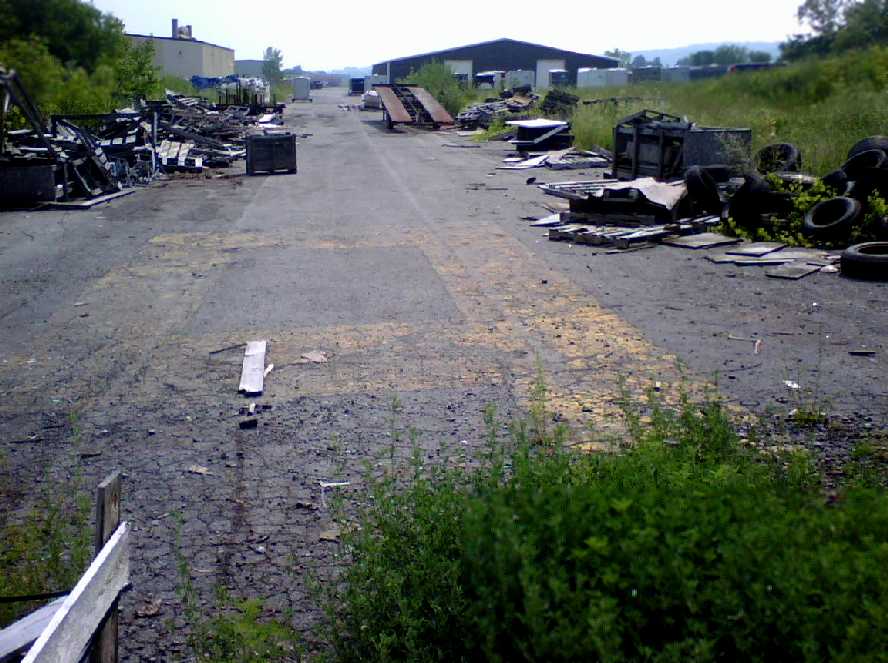
A 2008 photo by Peter Ricciardiello looking east
along the remains of Canastota's “Runway 9 approach end, with the faded runway number still visible.
This end of the runway is nothing more than a collection of tires, pallets, and trailers as seen in the picture.
Very sad end to what was once a very exciting ribbon of asphalt.”
The site of Canastota Airport is located at the intersection of Route 5 & Dominic Bruno Boulevard.
Thanks to John Buck for pointing out this airfield.
____________________________________________________
Kamp Airport (1B4), Durhamville, NY
43.135, -75.65 (East of Syracuse, NY)

The 1985 USGS topo map depicted Kamp Airport as having a single east/west runway.
This small general aviation airport was evidently built at some point between 1976-79,
as it was not listed in the 1976 AOPA Airport Directory (according to Chris Kennedy).
The earliest reference to Kamp Airport which has been located
was in the "Low Use Airports" section of the 1979 Flight Guide (according to Chris Kennedy).
Brien Miller recalled, “Kamp Airport was started by Bernie Kamp in answer to both some flying club politics
at both Canastota & another small airport just east of Lake Oneida.
Kamp's main hangar & FBO sported a decent fly-in lunch room but the runway was always narrow & its edges in bad shape.
You risked sucking broken asphalt into a prop if you got to close to the edge.
The parking area was even worse with its white pebble ground cover.
Also the end of Runway 28 was just short of one whopping tree.
The grass north/south strip was wide & generous but was crossed by the improved surface strip
and was a nasty bump if you landed late & had to roll out over it.
The power lines south of the field were no advantage either.
I much preferred flying out of Canastota, but when it closed the club first moved to Kamp.”
The 1982 AOPA Airport Directory (courtesy of Ed Drury)
described Kamp Airport as having a single 3,000' asphalt Runway 10/28,
listed the operator as Kamp Airport.
Kamp Airport was owned by Bernard & Marylin Kamp.
Mark Bailey recalled flying into Kamp Airport in the early 1980s.
"Kamp was a favorite place for us Aero Clubbers to fly most any Saturday we could.
The airport was busy then & sported a nice little cafe run by Susie.
Kamp also had a number of pancake breakfasts as well as an air show for a number of years.
There were trees on the west side of the field on the approach,
but other than that, it was a nice little field, and I am sorry to see it go."
The earliest depiction which has been located of Kamp Airport was on the 1985 USGS topo map.
It depicted Kamp Airport as having a single east/west runway.
Dan Leinbach recalled, “I remember popping over to Kamp with my dad in the Grumman Tiger his flying club owned.
To this probably 8-10 year old at the time, Kamp had THE BEST hamburgers anywhere.
Around 1990, the club (Ideal Flying Club) purchased a Rockwell Commander 114.
The Commander was at Kamp, getting some kind of work done on it.
As we returned to the aircraft, my mom asked 'Is the prop supposed to have that notch in it?'
Maybe 6" from the tip of the blade, there was a good inch-deep gouge.
When turning around on the broken asphalt, my dad had apparently picked up a chunk of it; he's lucky it didn't lose the blade tip on the short flight to KUCA.”

The 1994 USGS aerial photo depicted Kamp Airport as having a total of 5 light single-engine aircraft visible on the field,
parked around a cluster of small buildings & hangars on the northwest corner of the field.
Another building or hangar was located southwest of the runway intersection.

The 1995 Jeppesen Airport Directory depicted Kamp Airport
as having a 3,225' paved Runway 10/28 & a 3,750' unpaved Runway 17/35.
The offices of Kamp Air Aviation Inc. were depicted on a ramp northwest of the runway intersection,
and a radio-controlled model airplane flying field was depicted just north of the ramp.
Dan Leinbach recalled, “My personal experience with Kamp came around 1997.
The sole soft-field landing I have logged was at Kamp. [The] good bump when crossing the paved surface - I can attest to that.
It was one heck of a kick - enough to float me across the paved surface on that occasion.”
John Reep recalled of a visit to Kamp Airport, “in 1998... I purchased an Aero Commander Lark from a fellow in Chittenango, NY.
The airplane was not in particularly great condition,
and when I took off for Syracuse, I couldn't get the radios to cooperate.
Through the scratchy, weak radios, Syracuse approach advised me to head elsewhere,
and for some reason I had turned east.
I saw an airport on the chart & found it on the ground, and went to land there for fuel.
This airport turned out to be Kamp Airport.”
John continued, “It had, as I recall, one or 2 large hangars, painted with red & white stripes.
There were quite a few airplanes on the ramp.
The place had certainly seen better days.
Inside, there were 2 or 3 old-timers.
There was a pilot shop which mainly consisted of a glass display counter with items like fuel testers & other basics.
I bought a sectional chart & fuel.
There was also a kitchen right there in the place which seemed long abandoned.
Overall, the airport looked like a place that had once had a fine heyday but had become forgotten & forlorn.
I wished I had been there when it was at its peak.”
John reported that he was “amazed” to learn that Kamp Airport was evidently built in the 1970s.
“I would have guessed it was at least 10 years older than that.
I guess the place looked older than it really was.
When I departed it's long & very narrow paved runway,
I felt like I was leaving behind a part of General Aviation history; and I guess I really was.”

Kamp Airport was still listed in the 2001 AOPA Airport Directory.
The field was described as having a 3,2,25' asphalt Runway 10/28 & a 3,750' turf Runway 17/35.
The operator was listed as Kamp Air Aviation, Inc.
Note that the crosswind runway was incorrectly depicted as being perpendicular to the paved runway.
Brien Miller recalled, “I believe that Bernie [Kamp] passed away
which was the beginning of the end of Kamp Airport as the neighbors were hostile to it.
The [flying] club eventually moved to Syracuse International.”
According to the 2003 Annual Report of the NY Department of Transportation,
Kamp Airport was one of 2 public use airports in NY which closed in 2002 (the other was Angola).
"This airport was purchased by the Oneida Indian Nation, which closed it for aviation use."
[I guess that's fair, after all, given that we took the property from them a few hundred years ago!]

A circa 2000-2005 USGS aerial photo showed the field to remain completely intact.
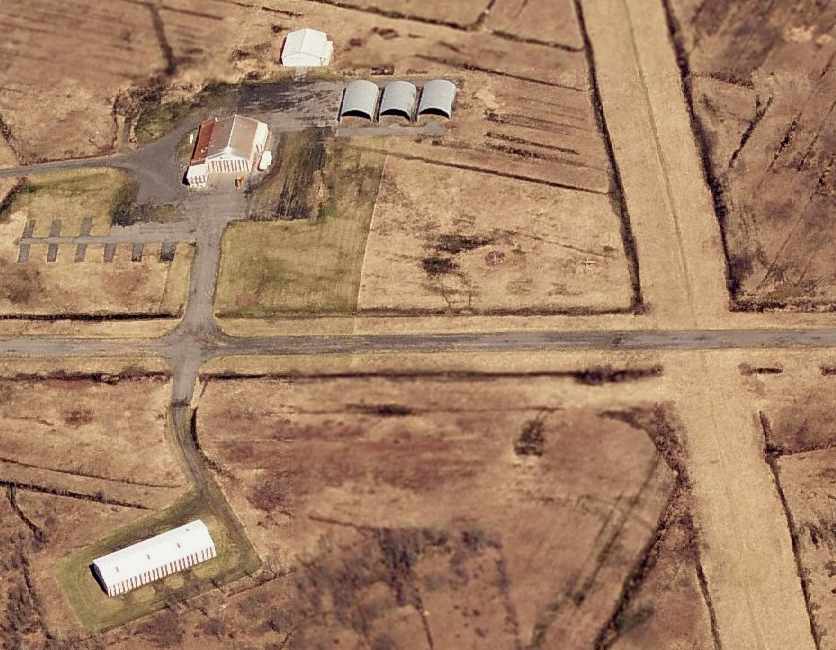
A circa 2006 aerial view looking north at the former hangars which remain at the site of Kamp Airport.

A 2008 aerial view by Phil Brooks looking east at Kamp Airport shows that the site remains intact,
with all of the hangars remained standing.
However the paved runway had deteriorated considerably.
Kamp Airport is located southeast of the intersection of Route 31 & Irish Ridge Road.
____________________________________________________
Syracuse Municipal Airport, Amboy, NY
43.07, -76.26 (Northwest of Syracuse, NY)

A 1927 photo of Charles Lindberg in front of his “Spirit of St.Louis” at Syracuse Airport.
to a crowd of 2000 people in 1927
According to the web site of the Syracuse Airport Aircraft Rescue & Fire Fighting Department (courtesy of Drew Van Horne),
the City of Syracuse (led by mayor & former WW1 flier Charles Hanna)
purchased the former Hinsdale farm in Amboy for $50,000 in 1926,
after deciding that Syracuse should have its own municipal airport.
The "Old Hinsdale Field" site was chosen as it was very level & offered room for expansion
(according to the Syracuse Hancock Field web site, courtesy of Drew Van Horne).
Syracuse City Airport (Municipal Field) officially opened in 1927,
and was operated by the city parks department.
The earliest photo which has been located of Syracuse Airport
was a 1927 photo of Charles Lindberg in front of his “Spirit of St.Louis” at Syracuse Airport.
He was greeted by a crowd of 2,000 people.
Thousands flocked to the grass strip for air shows that featured famed aviators & personalities of the day
such as Amelia Earhart, Kate Smith and Lowell Thomas.
The first airmail arrived at Syracuse City Airport on May 1, 1928.
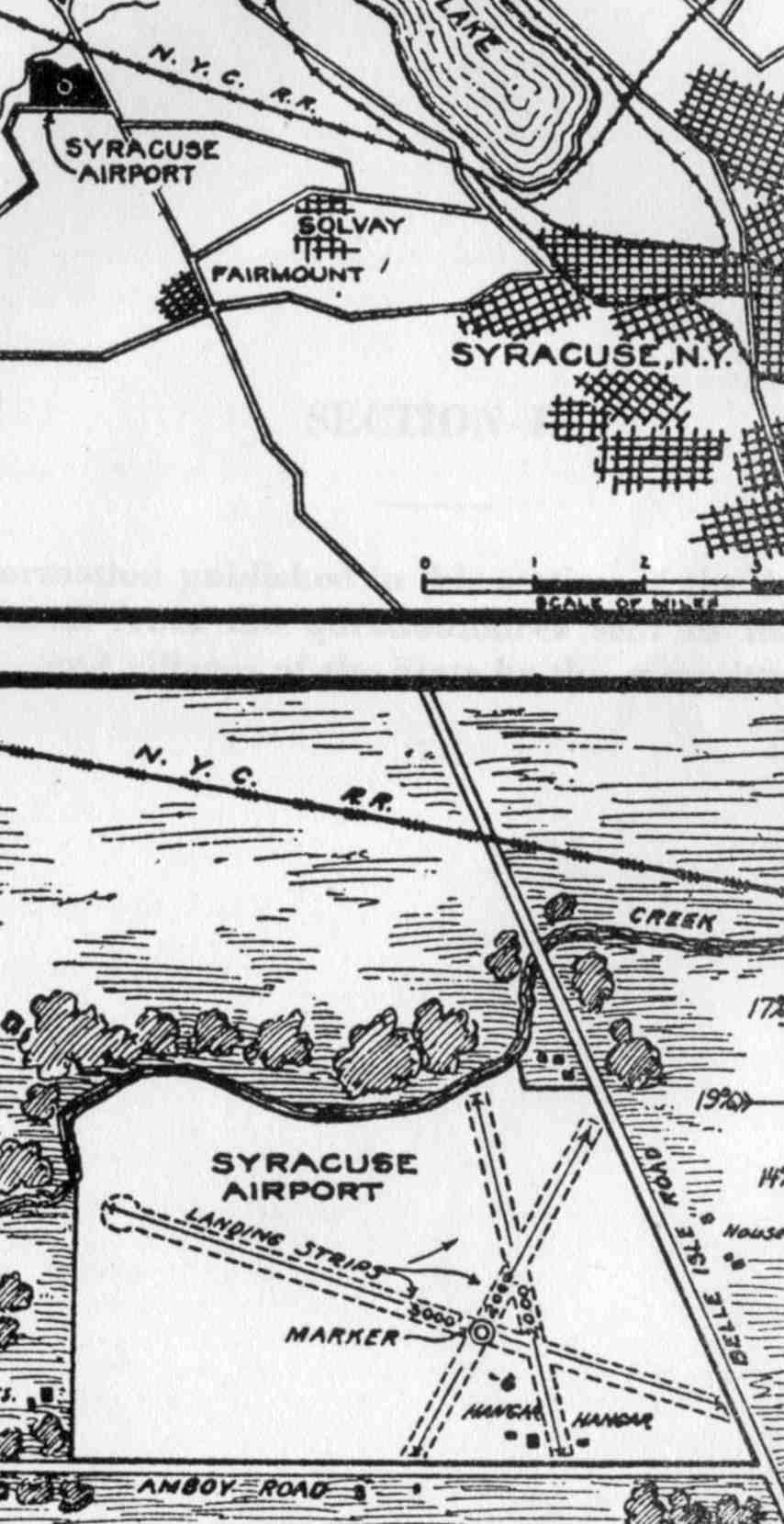
A 1929 NY Legislative Report (courtesy of Tom Heitzman) described Syracuse Airport as a 137 acre rectangular property having 3 runways,
the longest measuring 3,000' northwest/southeast.
The airfield was said to be owned & operated by the City of Syracuse.
The 1929 "Rand-McNally Standard Map of NY with Air Trails" (courtesy of Chris Kennedy)
described Syracuse Municipal Airport as having a 2,000' x 3,600' field.
American Airways' Ford Tri-Motors were routinely touching down on the airport's 3 grass runways by 1931.
On August 28, 1933, aviator Wiley Post landed at the Syracuse Airport in his "Winnie Mae".
Syracuse Municipal Airport, as depicted on a 1935 Regional Aeronautical Chart (courtesy of Scott O'Donnell).
An undated aerial view looking north at Syracuse Municipal Airport,
from The Airport Directory Company's 1937 Airports Directory (courtesy of Bob Rambo).
The field was described as having 2 sod runways,
with the longest being a 3,125' east/west strip.
The aerial photo in the directory depicted 2 hangars & at least one other building.

An undated business card for “Barnard Flying Service, Municipal Airport, Amboy” (courtesy of Tom Heitzman).

A September 6, 1938 aerial view of Syracuse Municipal Airport (from Cornell University, courtesy of Chris Kennedy)
showed that the field had been been upgraded with paved runways by 1938.
It was depicted as having 3 paved runways, oriented northwest/southeast, northeast/southwest, and north/south.
Two hangars were depicted in the aerial photo.

A closeup from the September 6, 1938 aerial view (from Cornell University, courtesy of Chris Kennedy)
showed 2 planes among the hangars at Syracuse Municipal Airport.
Airline traffic quickly outgrew Syracuse Municipal Airport,
and by the end of the 1930s, it was already somewhat behind the times.

An aerial view looking north at the Syracuse Municipal Airport,
from The Airport Directory Company's 1941 Airports Directory (courtesy of Chris Kennedy).
The field was described as having three 3,000' paved runways, oriented northwest/southeast, northeast/southwest, and north/south.
Two hangars were depicted in the aerial photo.

showing the field to have 3 paved runways, and several hangars southeast of the runway intersection.
Note the construction in the foreground, to extend the northeast/southwest runway further to the southwest.
With the outbreak of WW2, several local flying instructors at the Airport were pressed into military duty
and the Amboy City Airport became a flight training center.

The 1943 USGS topo map depicted Syracuse Municipal Airport as having 3 runways
and a ramp with several buildings south of the runway intersection.
The April 1944 US Army/Navy Directory of Airfields (courtesy of Ken Mercer)
described the field as having a 5,000' hard-surfaced runway,
and indicated that Army operations were conducted from the field.
The 1949 USAF Target Complex Chart (courtesy of Chris Kennedy)
depicted Syracuse Municipal Airport as having 3 paved runways
(with the longest being a 4,000' northwest/southeast strip),
and a ramp with at least 2 hangars south of the runway intersection.
Syracuse Municipal Airport was still depicted on the July 1949 Albany Sectional Chart (courtesy of Chris Kennedy),
but it was evidently closed within the next year,
as it was not depicted at all on the1950 Albany Sectional Chart (courtesy of Mike Keefe).
The reason for the airport's closure was that the much larger former Syracuse Army Air Base
had been rededicated on September 17, 1949 as the new Clarence E. Hancock Airport.
The original Syracuse Airport eventually became a chemical waste bed for Allied Chemical & Dye Corporation by 1951.

An October 5, 1951 aerial view of the site of Syracuse Municipal Airport (from Cornell University, courtesy of Chris Kennedy)
showed that the field had been reveloped as a dumping site,
but the hangars still remained standing, and most of the length of the runways remained intact as well.

Remains of 2 runways were still visible, as well as the ramp & the foundations of hangars.
A 1956 aerial view showed that the hangars had been removed at some point between 1950-56.
The southern & eastern portion of the airport site was labeled as "Tailings Pond" on the 1957 USGS topo map.
A 1972 aerial photo showed the majority of the land of the former airport had been thoroughly covered-over by a landfill,
with the exception of a hangar & a runway end on the west side.
From an overall inspection of the 1994 USGS aerial photo,
it appears as if not a trace of the former airfield still remained.
The majority of the land of the former airport had been thoroughly covered-over.

However, a closer inspection of the west side of the former airport on the 1994 USGS aerial photo
reveals a former hangar (at the top of the photo),
as well as a the distinct remains of the southwest end of the former northeast/southwest runway,
complete with its distinctive turnaround at the end of the runway.
A small parcel of land along the western portion of the site
was labeled as Reed Webster Park on 2003 road maps.
Kevin Kemp reported in 2004 of the former hangar on the west side of the site,
"From the side you can still see the painted 'Meyers Flyers' sign."

A circa 2001-2005 aerial view looking east at the former hangar which remains standing
on the northwest side of the former Syracuse Municipal Airport.

A circa 2001-2005 aerial view looking south at the southern end of the former northeast/southwest runway,
complete with a distinctive circular turnaround pad.
Although overgrown, the presence of asphalt has mad the outline of the former runway still remain perceptible.
The site of Syracuse Municipal Airport is located east of the intersection
of Route 173 & Airport Road (appropriately enough).
Thanks to Chris Kennedy for pointing out Syracuse Municipal Airport.
____________________________________________________
Nedrow Airpark (NY38), Nedrow, NY
42.965, -76.145 (South of Syracuse, NY)

Nedrow Airpark, as depicted on the July 1949 Albany Sectional Chart (courtesy of Chris Kennedy).
The date of construction of this small general aviation airport had not been determined.
Nedrow Airpark apparently dates back to before 1926,
as that is when "Nedrow Field" was considered by Syracuse Mayor Charles Hanna
as one of several sites for a new Syracuse Municipal Airport
(according to the Syracuse Hancock Field web site, courtesy of Drew Van Horne).
Nedrow was not chosen (for reasons not specified),
but instead continued to operate as a general aviation airport.
However, no airfield at this location was visible on a 9/6/38 aerial photo.
Nedrow Airpark was evidently temporarily closed during WW2
(like many other small civilian airports, due to wartime security concerns),
as it was not depicted on the 1943 USGS topo map nor on the 1945 Albany Sectional Chart (according to Chris Kennedy).
Nedrow apparently was reopened at some point between 1945-49,
as it was depicted as a commercial airport on the July 1949 Albany Sectional Chart (courtesy of Chris Kennedy).
According to Pat Lyons, “The Airpark was operated by my father, Francis W. 'Red' Lyons
for approximately 10 years starting around 1949/50.
I remember the grass runways well, as it was my job as a kid to cut the grass with an old tractor we had.
The office was at the far north end of the field
and there were a few (5) small hangars on the east side of the strip.
A wind sock stood at the entrance to the park in the far northeast corner.
I believe my father had a 10 year lease from the Onondaga Nation on the property.
My father was a very well-known pilot, flight instructor & regional flight examiner for the area.
He was known as 'Mr. Aviation of Our Community'
and there is a plaque honoring him at the current terminal of Hancock International Airport in Syracuse.”
The 1950 Albany Sectional Chart (courtesy of Mike Keefe)
described Nedrow Airpark as having a single 2,100' unpaved runway.
Bill Wilcox recalled "Nedrow Air Park was there in 1950-52.
I was a senior at Mexico NY & we had a gym cadet from Syracuse University who used to fly to school.
The SU flying club had at least one J-3 [Cub] they kept there.
I remember flying back to Syracuse with Joe,
and on one occasion I went there with a friend of his for a ride."

The earliest photo which has been located showing Nedrow Airpark was a 1954 aerial view looking northeast,
which 7 single-engine aircraft parked amidst some small hangars on the north side of a north/south grass runway.

The 1955 USGS topo map depicted Nedrow Air Park as having a single unpaved northeast/southwest runway.
The 1962 AOPA Airport Directory described Nedrow as having a single 2,100' turf Runway 18/36,
and listed the operator as Nedrow Airpark Inc.
According to Eric Hansen (Lockheed Martin Test Pilot),
"As a high school senior in 1966, our Air Force family moved to Syracuse, NY.
I had received my private pilot's license in Arkansas only a few months before,
and I was looking for a place to rent flying time to keep up my 'habit'.
My father was assigned as the Professor of Aerospace Studies at Syracuse University,
and the Air Force had a contract with Nedrow Air Park
to provide flight screening for ROTC cadets who were potential pilot candidates.
I got a special rate there."
"The chief pilot & airport manager was Marty Springer,
who had a Clark Gable look, with slicked back black hair & a mustache,
a bit rough around the edges, and wore an old leather flight jacket most of the time."
"The field was paved, and had the proverbial 50' trees at the north end,
requiring more than the usual pilot technique for landing, since the full 2,100' was only usable for takeoff.
I rented Cessna 172s there often enough to stay current,
as I finished high school & completed my 4 year degree at Syracuse University."

Nedrow Airpark was depicted on the July 1969 Albany Sectional Chart (courtesy of John Voss)
as having a single 2,200' paved runway.
Eric Hansen recalled, "My last flight out of Nedrow was in June of 1972,
when I was sent to Oklahoma to become an Air Force pilot myself."

A 5/21/72 USGS aerial view depicted a total of 4 single-engine aircraft parked amidst some small hangars on the northeast side of Nedrow Airpark.
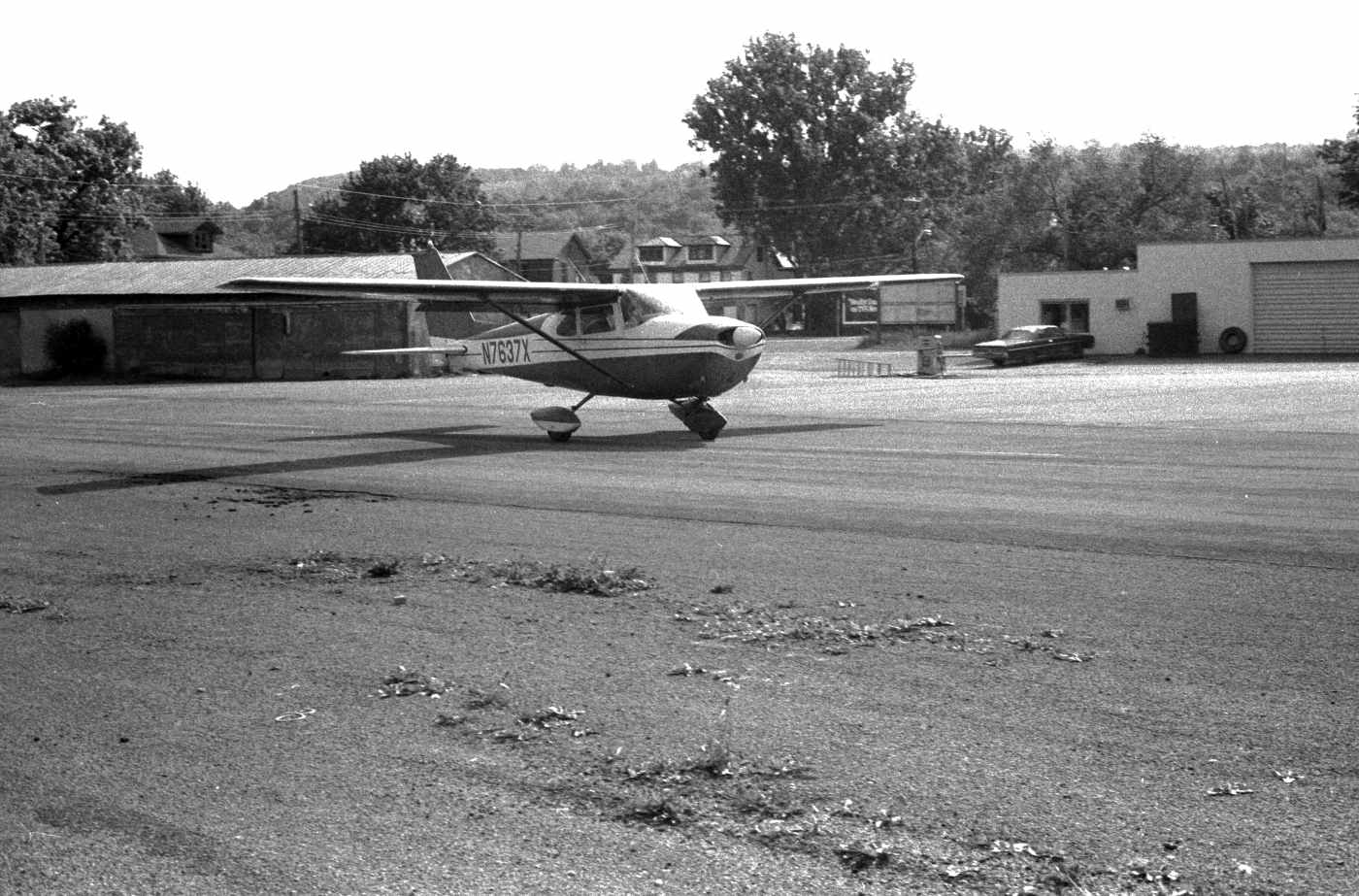
The last photo which has been located showing Nedrow Airpark while open
was a 6/3/74 photo by Alan Reddig looking east at Carl & K.C. Jeronimo departing in a Cessna 172 from Nedrow's Runway 21.

Nedrow Airpark was still depicted as an active airport in the 1979 Flight Guide (courtesy of Chris Kennedy).
It was depicted as having a single 2,100' paved Runway 3/21, with a parallel taxiway on the east side.
A total of 5 small buildings (hangars?) were depicted on the northeast corner of the field.
Nedrow Airpark was evidently closed within the next year,
as it was depicted as a closed airport on the 1980 Sectional Aeronautical Chart (courtesy of Ed Drury).
According to Brien Miller, “Nedrow was another sore point to local pilots, although that wasn't a strip I went into.
It was a fairly nice little valley-style field & one of the few in the area with a north/south alignment - due mostly to being in the vale of the Onondaga valley.
But the Onondaga Indian Tribe leveraged a law & took the property as well as a swath of the village.
Locals fought viciously but the tribe had a solid treaty.
It took them less than a week to convert the airport into a junk yard, bingo hall, and liquor store.
The South Syracuse pilots who flew from there remain bitter to this day.
Most moved to Cortland's Chase Field.”

In addition to the single runway, the 1988 USGS topo map depicted a parallel taxiway,
a small ramp with 2 buildings at the north end of the runway,
and what appeared to be a hexagonal hangar west of the runway.

In the 1995 USGS aerial photo (taken after the field's closure),
the airport & buildings still appeared to be completely intact.
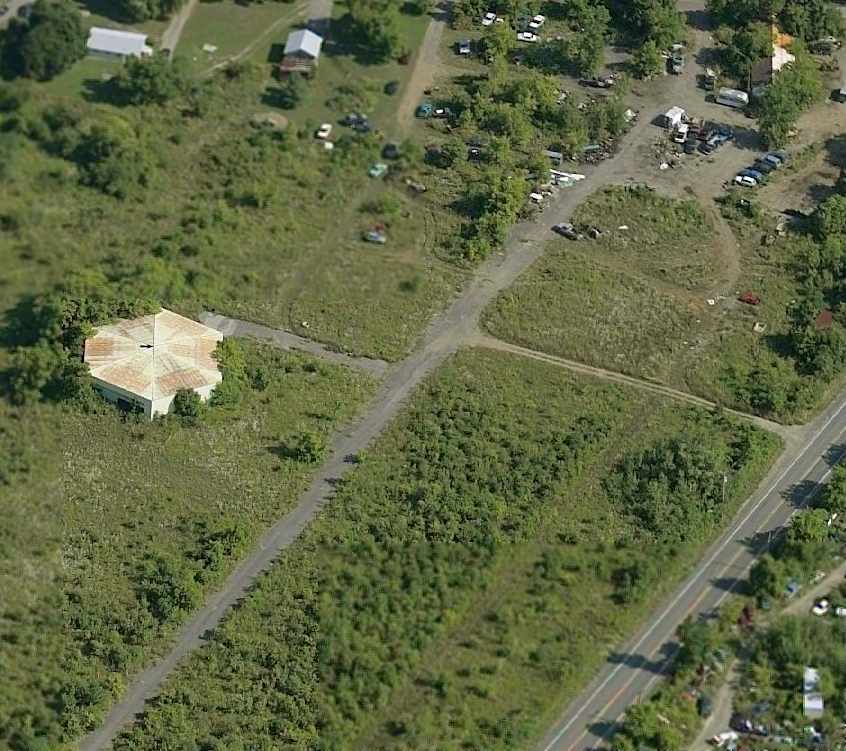
A circa 2005 aerial photo looking north at the former hexagonal hangar, runway, and ramp at the former Nedrow Airpark.
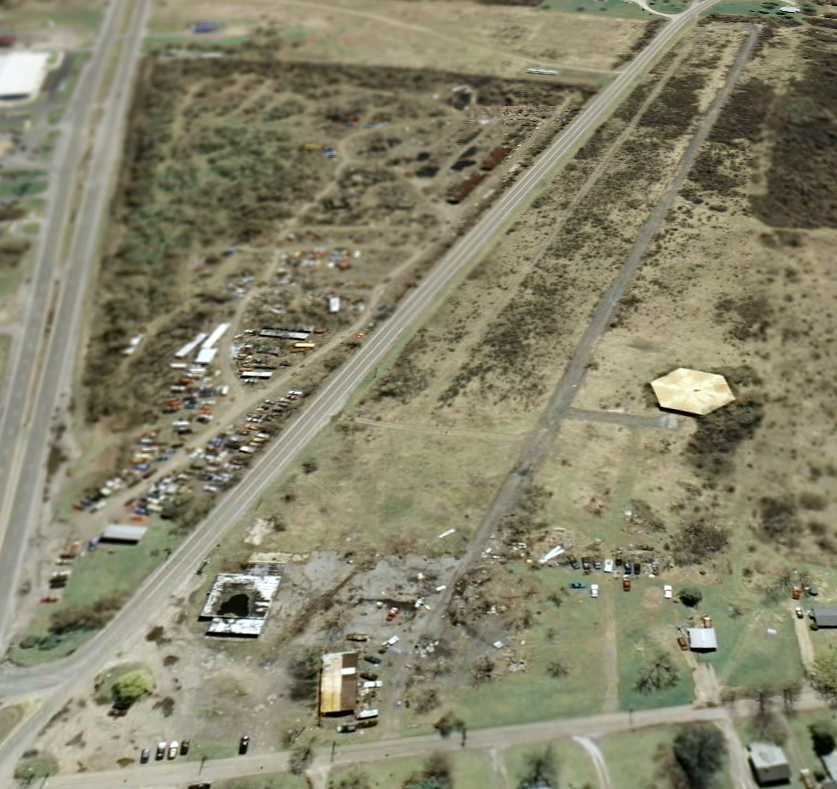
A 2006 aerial view looking south at the remains of the Nedrow Airpark.
The site of Nedrow Airpark is located within the Onondaga Indian Reservation,
southwest of the intersection of Route 11A & West Conklin Ave.
____________________________________________________
Since this site was first put on the web in 1999, its popularity has grown tremendously.
That has caused it to often exceed bandwidth limitations
set by the company which I pay to host it on the web.
If the total quantity of material on this site is to continue to grow,
it will require ever-increasing funding to pay its expenses.
Therefore, I request financial contributions from site visitors,
to help defray the increasing costs of the site
and ensure that it continues to be available & to grow.
What would you pay for a good aviation magazine, or a good aviation book?
Please consider a donation of an equivalent amount, at the least.
This site is not supported by commercial advertising –
it is purely supported by donations.
If you enjoy the site, and would like to make a financial contribution,
you
may use a credit card via
![]() ,
using one of 2 methods:
,
using one of 2 methods:
To make a one-time donation of an amount of your choice:
Or you can sign up for a $10 monthly subscription to help support the site on an ongoing basis:
Or if you prefer to contact me directly concerning a contribution (for a mailing address to send a check),
please contact me at: paulandterryfreeman@gmail.com
If you enjoy this web site, please support it with a financial contribution.
please contact me at: paulandterryfreeman@gmail.com
If you enjoy this web site, please support it with a financial contribution.
____________________________________________________
This site covers airfields in all 50 states.